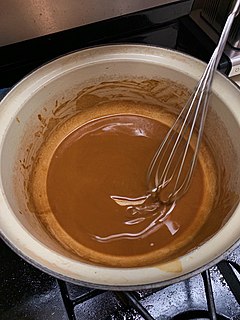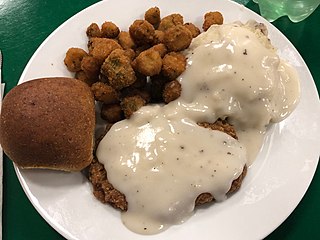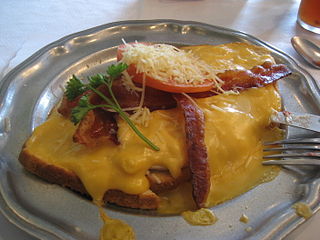Related Research Articles

The cuisine of the Southern United States encompasses diverse food traditions of several regions, including Tidewater, Appalachian, Lowcountry, Cajun, Creole, and Floribbean cuisine. In recent history, elements of Southern cuisine have spread to other parts the United States, influencing other types of American cuisine.

Roux is flour and fat cooked together and used to thicken sauces. Roux is typically made from equal parts of flour and fat by weight. The flour is added to the melted fat or oil on the stove top, blended until smooth, and cooked to the desired level of brownness. A roux can be white, blond (darker) or brown. Butter, bacon drippings or lard are commonly used fats. Roux is used as a thickening agent for gravy, sauces, soups and stews. It provides the base for a dish, and other ingredients are added after the roux is complete.

Chicken-fried steak, also known as country-fried steak or CFS, is an American breaded cutlet dish consisting of a piece of beefsteak coated with seasoned flour and either deep-fried or pan-fried. It is sometimes associated with the Southern cuisine of the United States. It is breaded and fried with a technique similar to the more common fried chicken, hence "chicken-fried". When deep-fried, it is usually referred to as "chicken-fried steak". Pan-fried versions are typically referred to as "country fried steak".

Singaporean cuisine is derived from several ethnic groups in Singapore and has developed through centuries of political, economic, and social changes in the cosmopolitan city-state.

Depression cake is a type of cake that was commonly made during the Great Depression. The ingredients include little or no milk, sugar, butter, or eggs, because the ingredients were then either expensive or hard to obtain. Similar cakes are known as "War Cake", as they avoided ingredients that were scarce or were being conserved for the use of soldiers. A common depression cake is also known as "Boiled Raisin Cake", "Milkless, Eggless, Butterless Cake", or "Poor Man's Cake". "Boiled" refers to the boiling of raisins with the sugar and spices to make a syrup base early in the recipe. However, some bakers do include butter. Boiled raisin-type cakes date back at least to the American Civil War.

Frybread is a flat dough bread, fried or deep-fried in oil, shortening, or lard. Made with simple ingredients, generally wheat flour, sugar, salt, and fat, frybread can be eaten alone or with various toppings such as honey, jam, powdered sugar, venison, or beef. Frybread can also be made into taco-like meals.
Norwegian cuisine in its traditional form is based largely on the raw materials readily available in Norway and its mountains, wilderness, and coast. It differs in many respects from continental cuisine through the stronger focus on game and fish. Many of the traditional dishes are the result of using conserved materials, necessary because of the long winters.

A flatbread is a bread made with flour; water, milk, yogurt, or other liquid; and salt, and then thoroughly rolled into flattened dough. Many flatbreads are unleavened, although some are leavened, such as pizza and pita bread.

The cuisine of Kentucky mostly resembles that of traditional Southern cuisine. Some common dinner dishes are fried catfish and hushpuppies, fried chicken and country fried steak. These are usually served with vegetables such as green beans, greens, pinto beans slow-cooked with pork as seasoning and served with cornbread. Other popular items include fried green tomatoes, cheese grits, corn pudding, fried okra, and chicken and dumplings, which can be found across the commonwealth.
The city of Ipoh is the administrative capital of the Malaysian state of Perak and is famous for its cuisine. Its food culture is driven by its majority Chinese population who are largely of Cantonese and Hakka descent. There is also excellent Malay and Indian food in Ipoh; the nasi kandar served by a prominent local Mamak stall is nicknamed nasi ganja due to its supposed addictive properties. Specialty foods from neighbouring towns are also available in Ipoh.
"Man of Constant Sorrow" is a traditional American folk song first published by Dick Burnett, a partially blind fiddler from Kentucky. The song was originally titled "Farewell Song" in a songbook by Burnett dated to around 1913. A version recorded by Emry Arthur in 1928 gave the song its current titles.

Spoonbread is a moist cornmeal-based dish prevalent in parts of the Southern United States. While the basic recipe involves the same core ingredients as cornbread — namely cornmeal, milk, butter, and eggs — the mode of preparation creates a final product with a soft, rather than crumbly, texture. As the name implies, the consistency is soft enough that it needs to be served and eaten with a spoon.

Belizean cuisine is an amalgamation of all ethnicities in the nation of Belize and their respectively wide variety of foods. Breakfast often consists of sides of bread, flour tortillas, or fry jacks that are often homemade and eaten with various cheeses. All are often accompanied with refried beans, cheeses, and various forms of eggs, etc. Inclusive is also cereal along with milk, coffee, or tea.
Jim Garland was a miner, songwriter, folksinger, and folk song collector from the coal mining country of eastern Kentucky, where he was involved with the communist-led National Miners Union (NMU) during the violent labor conflicts of the early 1930s called the Harlan County War.

A great variety of cassava-based dishes are consumed in the regions where cassava is cultivated, and the ingredient is included many national or ethnic specialities.

In the United States and Canada, a biscuit is a variety of baked bread with a firm, dry exterior and a soft, crumbly interior. It is made with baking powder as a chemical leavening agent rather than yeast, and at times is called baking powder biscuit to differentiate it from other types. Like other forms of bread, a biscuit is often served with butter or other condiments, flavored with other ingredients, or combined with other types of food to make sandwiches or other dishes.

Texan cuisine is the food associated with the Southern U.S. state of Texas, including its native Southwestern cuisine influenced Tex-Mex foods. Texas is a large state, and its cuisine has been influenced by a wide range of cultures, including Southern, German, Czech, British, African American, Creole/Cajun, Mexican, New Mexican, Native American, Asian, Jewish, and Italian.
Sarah Ogan Gunning was an American singer and songwriter from the coal mining country of eastern Kentucky, as were her older half-sister Aunt Molly Jackson and her brother Jim Garland. Although she made an appearance in the New York folk music scene of the 1930s, she was overshadowed by her older brother and half-sister. Rediscovered in the 1960s while living in Detroit, she played at folk festivals at Newport in 1964 and the University of Chicago in 1965.
References
- 1 2 Dreiser, Theodore; Cohen, Lester (2008). Harlan Miners Speak: Report on Terrorism in the Kentucky Coal Fields. Lexington, KY: University Press of Kentucky. p. 85. ISBN 978-0-8131-9187-4.
- ↑ Willigen, John van; Willigen, Anne van (2009) [2006]. Food and Everyday Life on Kentucky Family Farms, 1920-1950. Lexington, KY: University Press of Kentucky. pp. 17–18. ISBN 978-0-8131-4977-6.
- ↑ "I Am A Girl of Constant Sorrow (SARAH OGAN GUNNING) (1930s)". www.folkarchive.de. Archived from the original on 2002-06-10. Retrieved 31 January 2020.
- ↑ "Antiwar Songs (AWS): Sarah Ogan Gunning - Come All You Coal Miners". www.antiwarsongs.org. Archived from the original on 2015-01-13. Retrieved 31 January 2020.